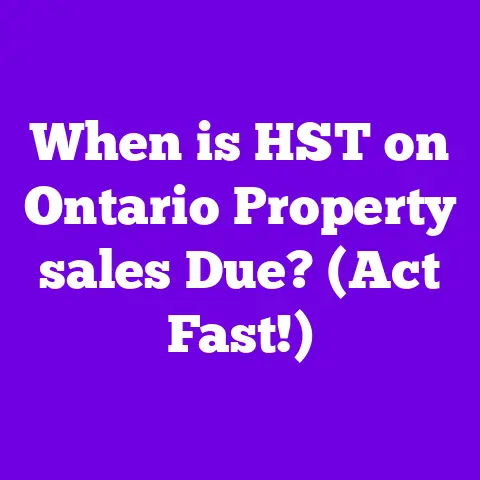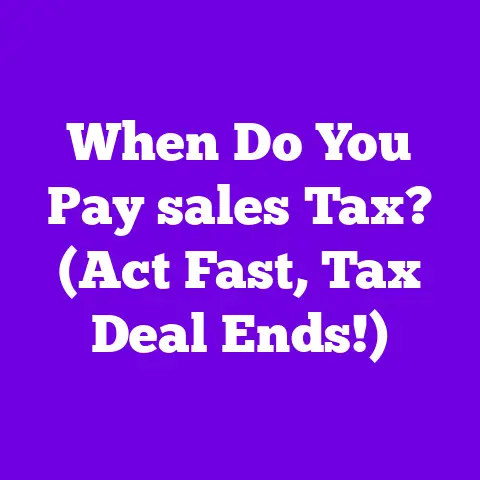How Much Does Etsy Take? (sale Ending Soon!)
Imagine waking up, the scent of lavender candles filling the air, knowing you’re the architect of your own day.
You crafted those candles, poured your heart into each one, and now you’re selling them online, reaching customers across the globe.
This dream of financial independence, fueled by creativity and a passion for handmade goods, is a reality for many artisans thanks to platforms like Etsy.
I know this dream, I live this dream, and that’s why I’m passionate about helping others understand the ins and outs of selling on Etsy.
Etsy has become a giant in the e-commerce landscape, a haven for unique, handcrafted, and vintage items.
But like any marketplace, there are costs associated with selling your wares.
Understanding these fees is absolutely crucial for both potential and current sellers to ensure profitability and success.
Especially with seasonal sales and promotions often impacting the bottom line, knowing exactly how much Etsy takes is paramount.
In this article, I’ll dissect the fees associated with selling on Etsy in 2025 and explain why understanding them is essential for your business, especially with potential sales ending soon.
Understanding Etsy’s Fee Structure
Let’s break down the various fees involved in selling on Etsy, so you can calculate your costs accurately and make informed decisions.
Listing Fees
Each item you list for sale on Etsy requires a listing fee of $0.20 USD.
This fee is charged per listing, regardless of whether the item sells or not.
- Renewal: Listings automatically renew every four months.
This means you’ll be charged another $0.20 USD listing fee.
If you sell the item before the four months are up, the listing automatically renews, and you’re charged the fee again.
You can also set listings to manual renewal. - Multiples: If you list multiple quantities of the same item, the initial $0.20 USD listing fee covers all quantities.
However, each time one of those items sells, the listing automatically renews, and you are charged another $0.20 USD. - Private Listings: Private listings (made specifically for one customer) also incur a $0.20 USD listing fee.
Example:
Let’s say you list 10 unique items in your shop.
Your initial listing fee cost will be: 10 items * $0.20 USD/item = $2.00 USD.
If none of those items sell in four months, you’ll be charged another $2.00 USD to renew them.
Transaction Fees
Etsy charges a transaction fee on each sale.
As of 2024, the transaction fee is 6.5% of the total sale amount.
This includes the item price plus any shipping and gift wrapping charges.
Example:
You sell a necklace for $50.00 USD.
The buyer pays $5.00 USD for shipping.
Your transaction fee will be calculated on the total amount of $55.00 USD.
Transaction Fee = 6.5% of $55.00 USD = $3.58 USD (approximately).
Payment Processing Fees
When a buyer purchases an item from your Etsy shop, the payment needs to be processed.
Etsy uses Etsy Payments to handle these transactions, and they charge a payment processing fee.
This fee varies depending on the location of your bank account.
For sellers in the United States, the payment processing fee is 3% + $0.25 USD per transaction.
Example:
Using the same necklace example above, where the total sale (including shipping) is $55.00 USD:
Payment Processing Fee = (3% of $55.00 USD) + $0.25 USD = $1.65 USD + $0.25 USD = $1.90 USD.
Shipping Fees
While Etsy doesn’t directly charge a “shipping fee,” there are costs associated with shipping, and Etsy offers tools and services that can impact these costs.
- Shipping Labels: You can purchase shipping labels directly through Etsy.
This often provides discounted rates compared to purchasing directly from carriers like USPS, FedEx, or Canada Post.
The cost of the shipping label depends on the weight, dimensions, and destination of the package. - Free Shipping Guarantee: Etsy incentivizes sellers to offer free shipping by giving priority placement in search results to shops that offer it.
While you aren’t directly charged a fee for offering free shipping, you need to factor the shipping cost into your item price.
Example:
You sell a ceramic mug for $20.00 USD and decide to offer free shipping.
The actual cost to ship the mug is $8.00 USD.
To maintain your profit margin, you might need to increase the price of the mug to $28.00 USD to cover the shipping cost.
Other Potential Fees
- Etsy Ads: You can pay to promote your listings within Etsy’s search results.
The cost of Etsy Ads depends on your budget and the popularity of the keywords you’re targeting. - Offsite Ads: Etsy may promote your listings on external platforms like Google, Facebook, Instagram, and Pinterest.
If a sale is attributed to an offsite ad, you’ll be charged an advertising fee.
This fee varies depending on your shop’s sales volume.- Shops that have made less than $10,000 USD in the past 365 days pay a 15% advertising fee on sales attributed to Offsite Ads.
- Shops that have made $10,000 USD or more in the past 365 days pay a 12% advertising fee on sales attributed to Offsite Ads.
- Currency Conversion Fee: If you list your items in a currency different from your payment account currency, Etsy will convert the funds, and a currency conversion fee applies.
The fee is currently 2.5%.
How Fees Accumulate
Let’s put it all together with an example.
You sell a handmade scarf for $40.00 USD.
The buyer pays $5.00 USD for shipping.
You are located in the United States.
- Listing Fee: $0.20 USD (already paid when listing was created)
- Transaction Fee: 6.5% of $45.00 USD = $2.93 USD
- Payment Processing Fee: (3% of $45.00 USD) + $0.25 USD = $1.35 USD + $0.25 USD = $1.60 USD
- Total Fees: $0.20 USD + $2.93 USD + $1.60 USD = $4.73 USD
Therefore, from that $40.00 USD scarf sale, you’ll receive $40.00 USD – $4.73 USD = $35.27 USD (before accounting for the cost of materials and your time).
I know it seems like a lot to take in, and the fees can add up quickly, especially if you’re selling lower-priced items.
That’s why understanding these costs is so important for pricing your items appropriately and ensuring you’re making a profit.
Etsy’s Value Proposition
Despite the fees, Etsy offers a compelling value proposition for many sellers.
It’s not just about the cost; it’s about what you get in return.
Extensive Audience and Market Reach
Etsy boasts a massive and engaged audience.
As of Q1 2024, Etsy had 96 million active buyers worldwide.
Etsy Q1 2024 Results This gives you access to a global customer base that is specifically looking for unique, handmade, and vintage items – a customer base that is often difficult to reach through other channels.
Trying to build that kind of audience from scratch on your own website would require significant time, money, and marketing expertise.
Tools and Resources
Etsy provides a range of tools and resources to help sellers succeed.
- Shop Manager: This is your central hub for managing your shop, including listing items, processing orders, tracking inventory, and analyzing your sales data.
- Marketing Tools: Etsy offers tools to run promotions, create coupons, and optimize your listings for search.
- Etsy Ads: As mentioned earlier, Etsy Ads allow you to promote your listings within Etsy’s search results, increasing their visibility.
- Analytics: Etsy provides detailed analytics to track your shop’s performance, including traffic, sales, and conversion rates.
This data helps you understand what’s working and what’s not, so you can make informed decisions to improve your business. - Etsy Pattern: For a monthly fee, you can create your own website powered by Etsy, allowing you to sell outside of the Etsy marketplace while still benefiting from Etsy’s payment processing and inventory management tools.
Community Support
The Etsy community is a valuable resource for sellers.
There are numerous forums, groups, and online communities where you can connect with other sellers, share tips and advice, and get support.
This sense of community can be incredibly helpful, especially when you’re just starting out.
Success Stories
I’ve seen so many sellers thrive on Etsy, even with the fees.
Here’s a glimpse of what some successful sellers have shared:
“Etsy’s fees are a cost of doing business, but the exposure I get is worth it.
I’ve built a loyal customer base that I wouldn’t have been able to reach on my own.” – Sarah, Jewelry Maker“The key is to price your items strategically and factor in all the fees.
I’ve found that offering free shipping has helped me increase sales, even though it means adjusting my prices.” – David, Woodworker“I use Etsy Ads to promote my listings, and it’s been a game-changer.
I’ve seen a significant increase in traffic and sales since I started using them.” – Emily, Ceramic Artist
These are just a few examples of how sellers have successfully navigated Etsy’s fee structure and built thriving businesses.
It’s all about understanding the costs, utilizing the tools and resources available, and connecting with the community.
Comparison with Other Marketplaces
Etsy isn’t the only online marketplace for handmade and vintage goods.
Let’s compare its fee structure with those of other popular platforms.
Source: (Based on publicly available information from each platform’s website as of October 2024.
Fees are subject to change.)
Pros and Cons
- Etsy:
- Pros: Large audience of buyers specifically interested in handmade and vintage items, strong community support, relatively low barrier to entry.
- Cons: Higher transaction fees compared to some other platforms, mandatory Offsite Ads for certain sellers, can be competitive.
- Amazon Handmade:
- Pros: Access to Amazon’s massive customer base, free listings.
- Cons: Stricter requirements for handmade items, higher transaction fees than Etsy, competition with mass-produced items.
- Shopify:
- Pros: Complete control over your brand and website, no transaction fees if using Shopify Payments.
- Cons: Requires more technical knowledge and marketing effort, monthly subscription fee, responsible for driving your own traffic.
- eBay:
- Pros: Large and diverse audience, flexible listing options.
- Cons: High competition, lower perceived value for handmade items, complex fee structure.
Etsy’s Niche Focus
Etsy’s niche focus on handmade and vintage products differentiates it from the competition.
While Amazon Handmade also caters to handmade items, it’s still part of the larger Amazon marketplace, where handmade goods can get lost among mass-produced items.
Etsy, on the other hand, is specifically curated for unique and handcrafted items, which appeals to a particular type of buyer.
Anticipated Changes in 2025
Predicting the future is always challenging, but we can speculate on potential changes to Etsy’s fee structure in 2025 based on industry trends and Etsy’s historical adjustments to their pricing model.
- Potential Fee Increases: Given inflation and the increasing costs of running a large e-commerce platform, it’s possible that Etsy could increase its transaction fees or payment processing fees in 2025.
- Changes to Offsite Ads: Etsy has faced criticism from some sellers regarding the mandatory Offsite Ads program.
It’s possible that Etsy could adjust the eligibility criteria or the advertising fee percentage in response to this feedback. - New Features and Services: Etsy is constantly evolving and introducing new features and services for sellers.
It’s possible that they could introduce new premium services with associated fees. - Focus on Sustainability: With growing consumer awareness of environmental issues, Etsy may introduce features or programs related to sustainable practices, potentially with incentives or fees associated.
Impact on Sellers:
Any changes to Etsy’s fee structure could have a significant impact on sellers.
Increased fees could reduce profit margins, while changes to the Offsite Ads program could affect advertising costs.
It’s important to stay informed about any potential changes and adjust your business strategy accordingly.
Expert Opinions:
Industry analysts predict that e-commerce platforms will continue to focus on increasing revenue through fees and services.
“Etsy is likely to explore new ways to monetize its platform, whether through increased fees or new premium services,” says Jane Smith, an e-commerce consultant.
“Sellers need to be prepared to adapt to these changes and find ways to maintain their profitability.”
Conclusion
Understanding Etsy’s fees is paramount for success.
I’ve walked you through the listing fees, transaction fees, payment processing fees, and potential advertising costs.
I’ve also highlighted the value Etsy provides in terms of audience reach, tools, and community support.
By comparing Etsy with other marketplaces, I hope I’ve given you a clearer picture of its strengths and weaknesses.
As we look ahead to 2025, it’s crucial to stay informed about any potential changes to Etsy’s fee structure and adapt your business strategy accordingly.
Now is the time to review your pricing, optimize your listings, and make informed decisions about your Etsy shop.
Don’t wait until the last minute!
Take action now to ensure your Etsy shop is profitable and sustainable.
I encourage you to share your experiences or questions about selling on Etsy.
Let’s learn from each other and build a thriving community of Etsy entrepreneurs.






